
Archytas is a lunar impact crater that protrudes into the northern edge of Mare Frigoris. To the northwest is the comparably sized crater Timaeus, and the smaller Protagoras lies in the opposite direction to the southeast. Further to the southwest, beyond the opposite edge of the mare, is the dark-floored crater Plato.
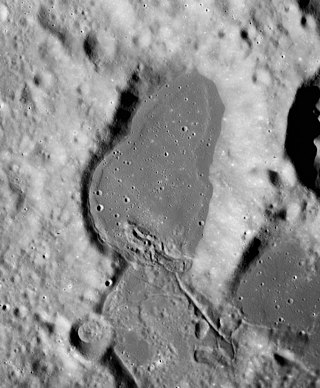
Bowditch is a lunar impact crater that lies on the far side of the Moon, just beyond the eastern limb. It is located on a region of the lunar surface that is brought into view due to libration, but at such times the area is viewed from the edge and so not much detail can be observed. It lies just to the north of the small Lacus Solitudinis lunar mare, between the craters Titius to the southwest and Perel'man to the east-northeast.

Banachiewicz is a largely degraded lunar impact crater that is located near the eastern limb of the Moon.
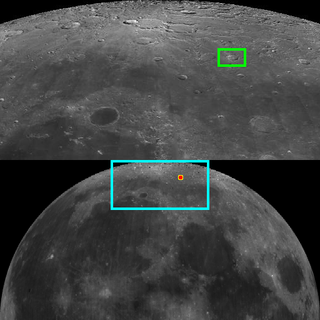
C. Mayer is a lunar impact crater that is located at the northern edge of the Mare Frigoris, due north of the prominent crater Aristoteles. Also to the south, but only a third as distant, is the smaller crater Sheepshanks. Due east of C. Mayer is the flooded crater Kane.
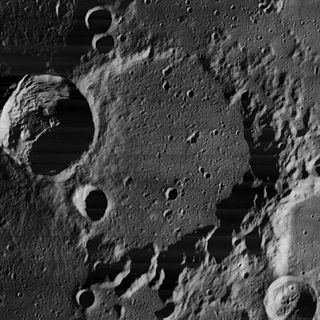
Goldschmidt is a large lunar impact crater of the variety commonly termed a walled plain. It lies in the northern part of the Moon's near side, and appears oval in shape due to foreshortening. The rim is actually relatively circular, although the western rim is overlain by the prominent crater Anaxagoras. Nearly attached to the southeast rim is Barrow, and the two formations are separated by a rugged rise about 30 kilometers across. Further to the south is Epigenes.

Buffon is a lunar impact crater that is located on the southern hemisphere on the far side of the Moon. It lies a crater diameter south of the large walled plain Chebyshev. To the northeast is the crater Langmuir and to the southwest is Leavitt. Buffon lies nearly at the midpoint between these formations.

Mercurius is a lunar impact crater that is located in the northeastern part of the Moon. It lies to the northeast of the smaller crater Carrington, and west-northwest of Zeno. Just to the south is the small lunar mare named Lacus Spei, and to the west is the larger Lacus Temporis.

Pitiscus is a lunar impact crater that lies in the southern part of the Moon's near side, just to the northwest of the larger crater Hommel. It was named after German mathematician Bartholomaeus Pitiscus in 1935. The crater is worn, but still forms a prominent feature upon the surface. The rim is roughly circular, but appears oval from the Earth due to foreshortening. There is an outward bulge to the south-southeast where the interior has slumped. The remainder of the inner wall still displays terraces, although they are worn and rounded due to erosion.

Xenophanes is a lunar impact crater that is located along the northwestern limb of the Moon. It is nearly attached to Volta, a similar formation to the south-southwest. To the northeast is the smaller crater Cleostratus. Xenophanes is significantly foreshortened when viewed from the Earth, hindering observation.

Chebyshev is a large lunar impact crater that lies in the southern hemisphere on the far side of the Moon. The somewhat smaller crater Langmuir is intruding into the east-southeastern rim of Chebyshev, forming a chain of large craters with Brouwer on Langmuir's eastern rim.

Chrétien is a lunar impact crater that is located in the southern hemisphere on the far side of the Moon from the Earth. It lies due south of the Mare Ingenii, one of the few maria on the Moon's far side. The crater lies in the midpoint between the craters Garavito to the west-southwest and Oresme to the east-northeast, both of these being somewhat smaller than Chrétien.
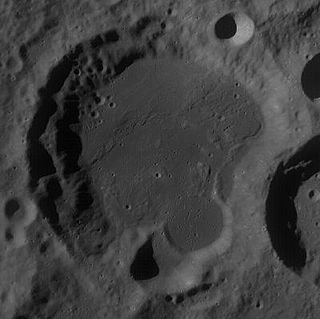
Crocco is a lunar impact crater that is located on the far side of the Moon from the Earth. It is located to the northeast of the huge walled plain Planck, and northwest of the equally huge Poincaré. Just to the north, within one crater diameter, is the crater Koch.

Campbell is a large lunar impact crater that is located in the northern hemisphere on the far side of the Moon. It lies to the southwest of the walled plain D'Alembert, an even larger formation. If Campbell were located on the near side of the Moon as seen from the Earth, it would form one of the largest visible craters, being slightly larger than Schickard. It is bordered by several craters of note, with Wiener to the southwest, Von Neumann just to the south, Ley overlying the southeast rim, and Pawsey to the west.

d'Alembert is a large lunar impact crater located in the northern hemisphere on the far side of the Moon, to the northeast of the somewhat smaller walled plain Campbell. Astride the southwest rim of d'Alembert is Slipher. To the north is the crater Yamamoto, and to the south-southwest lies Langevin. This walled plain has the same diameter as Clavius on the near side, making it one of the largest such formations on the Moon.

Leibnitz is a huge lunar impact crater that is located in the southern hemisphere on the far side of the Moon. This formation is the same size as Clavius on the near side. It is located to the east-southeast of Mare Ingenii, and is joined to the northeast rim of Von Kármán. Attached to the eastern rim of Leibnitz is Davisson, and intruding into the southeast rim is Finsen. Farther to the west is the large Oppenheimer.

Lamb is a lunar crater that lies beyond the southeastern limb on the Moon's far side. It is located in an irregular lunar mare region named Mare Australe, just to the east of the crater Jenner.

Hubble is a lunar impact crater that lies very near the east-northeastern limb of the Moon. At this location it is viewed almost from the side from Earth, and the visibility of this feature is affected by libration. It lies to the north of the Mare Marginis and northeast of the crater Cannon. About one crater diameter to the north-northeast is Lyapunov.

Plutarch is a lunar impact crater that lies near the north-northeastern limb of the Moon, just to the south of the irregular crater Seneca. To the southeast is the flooded crater Cannon. The proximity of this crater to the limb causes it to appear foreshortened when viewed from the Earth, but it is actually a circular formation.
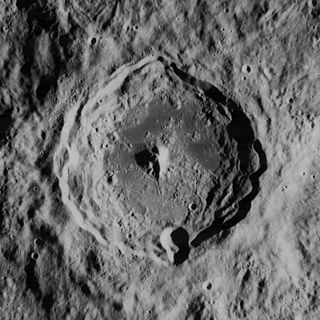
Schlüter is a lunar impact crater that is located near the western limb of the Moon's near side. It lies along the northwestern face of the Montes Cordillera mountain range that encircles the Mare Orientale. Nearly attached to the eastern rim is the damaged crater Hartwig.

Jenner is a lunar crater that is located within the Mare Australe. It lies just past the southeastern limb, on the far side of the Moon, and can be viewed from the Earth during periods of favorable libration and lighting. Nearly attached to the eastern outer rim of Jenner is the larger, flooded crater Lamb.






















